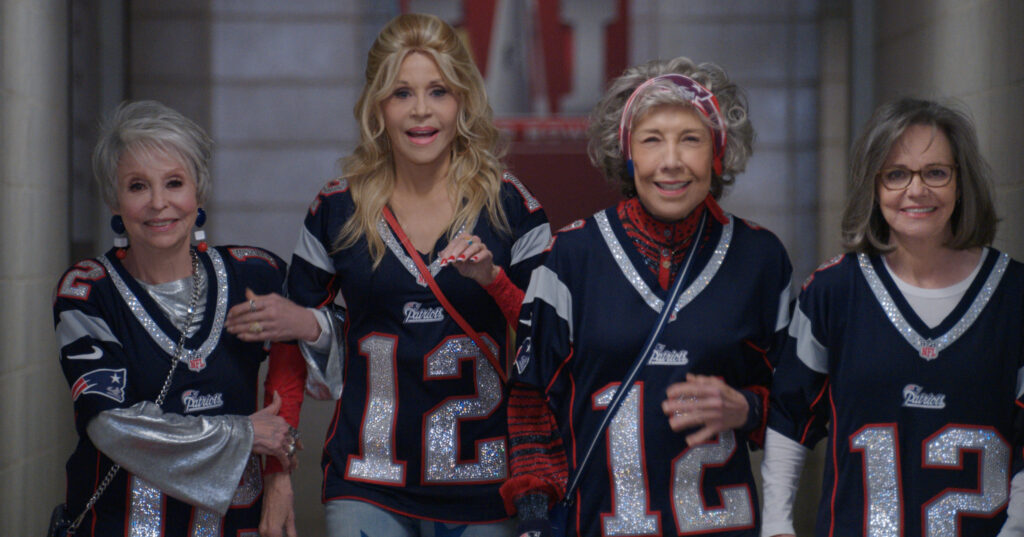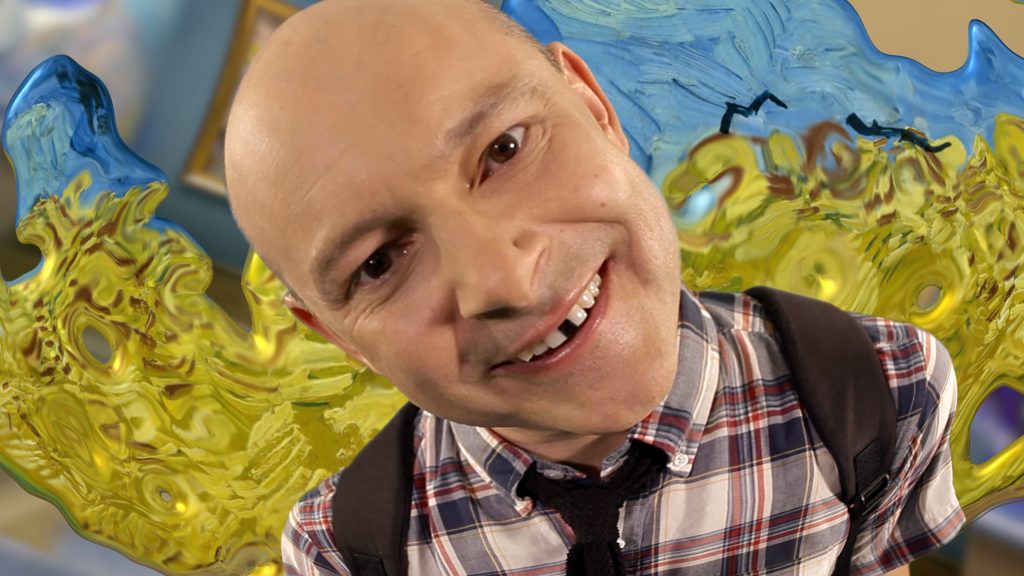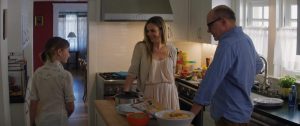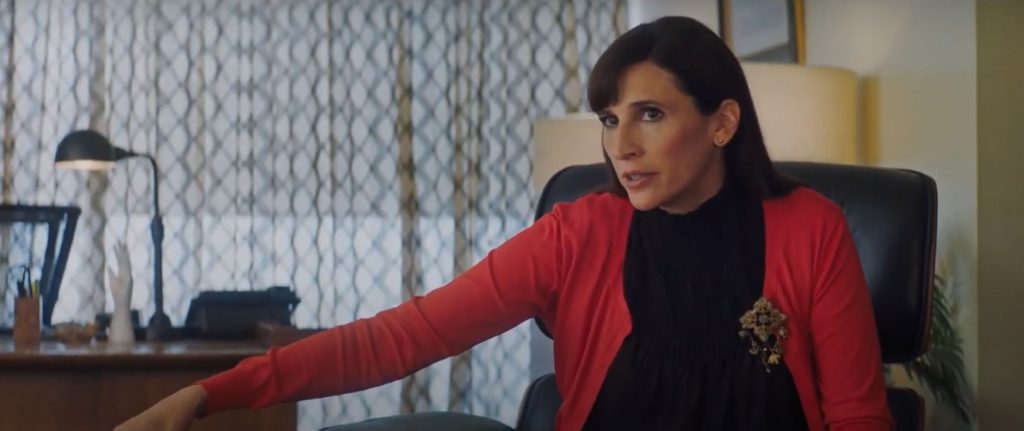January 28, 2023
by Carla Hay

Directed by Kyle Marvin
Culture Representation: Taking place in Boston and in Houston, in 2017 and briefly in 2020, the comedy film “80 for Brady” (inspired by a true story) features a predominantly white cast of characters (with some African Americans, Latinos and Asians) representing the working-class, middle-class and wealthy.
Culture Clash: Four elderly women best friends, who superfans of football star Tom Brady, win a contest to go to Super Bowl LI, and experience various hijinks before and after they lose their Super Bowl tickets.
Culture Audience: “80 for Brady” will appeal primarily to people who are fans the movie’s stars, American football and movies about senior citizens who have a zest for life.

As lightweight as a styrofoam football, “80 for Brady” is a transparently old-fashioned comedy about four female fans of Tom Brady who go on a Super Bowl adventure. The cast members’ chemistry is the main reason to watch, because the jokes are hit and miss. This is the type of movie where you know even before it starts how it’s going to end, but it’s still a breezy and inoffensive ride that should bring some mild grins even to the most cynical viewers.
Directed by Kyle Marvin, “80 for Brady” is inspired by a true story and has a trailer where about 80% of the plot is revealed. Even without seeing the trailer or knowing anything about “80 to Brady” before seeing the film, viewers will know about 15 minutes into the movie what to expect. The “80 for Brady” screenplay by Emily Halpern and Sarah Haskins has many hokey sitcom-ish elements that could have been a lot more cringeworthy if not for the immense talents of the four principal actresses at the center of the story. It also helps that all four actresses are entirely believable in their “80 for Brady” roles as longtime best friends.
Lily Tomlin portrays Louella, nicknamed Lou, the group’s most enthusiastic risk-taker. Jane Fonda is Patricia, nicknamed Trish, who is a flirtatious and fun-loving divorcée. Rita Moreno has the role of sassy widow Maura Martinez, whose husband Francisco died the previous year. Sally Field depicts sensible and socially inhibited Elizabeth “Betty” Bachman, a retired Massachusetts Institute of Technology professor of applied mathematics. Betty is the only one in this group of four who is married; she’s been married to her husband Mark (played by Bob Balaban) for 51 years. All four of these female friends are in their 80s, except for Betty, who is 75.
The story of “80 for Brady” begins in Boston in 2017, when these four New England Patriots superfans look forward to watching Super Bowl LI, where the New England Patriots will be playing against the Atlanta Falcons at NRG Stadium in Houston. Fans of American football already know that Super Bowl LI had one of the most stunning victories in Super Bowl in history, so it’s no surprise that it would eventually be recreated in a scripted film. The four Patriot superfans in “80 for Brady” would love to go to the Super Bowl in person, but they can’t afford the trip and the price of the Super Bowl tickets.
As explained early on in the movie, these four best friends are particularly fond of quarterback Tom Brady. They’ve adored him, ever since 2001, his first year with the New England Patriots. However, Trish also has a big crush for Rob Gronkowski, who was the tight end for the New England Patriots at the time.
Trish has such lustful admiration of Gronkowski, she’s turned her steamy fan fiction about him into bestselling romance novels. Trish has the author pseudonym Virginia Le Doux, the name of a poodle that Trish used to own. Her current book is called “Between a Gronk and a Hard Place.” Gronkowski makes a cameo in “80 for Brady,” as already shown in the movie’s trailer. Other former National Football League (NFL) stars who make cameos in “80 for Brady” are Marshawn Lynch, Danny Amendola and Julian Edelman.
Lou, Trish, Maura and Betty are avid viewers of a TV show for New England Patriots fans called “Pats Nation,” hosted by two guys named Nat (played by Alex Moffat) and Pat (played by Rob Corddry), who announce that the show is giving away free tickets to Super Bowl LI. The winner will be whoever “Pats Nation” thinks has the best story for why that person deserves to go to Super Bowl LI. Only one entry per person is allowed. And so begins a not-very-funny stretch of the movie where Lou, Trish, Maura and Betty all come up with different ways to make their statements for the contest.
This part of the movie looks very outdated, because people enter the contest by calling a hotline phone number and saying why they deserve to go to the Super Bowl. Haven’t these people ever heard of online technology? Maura, who lives at a group home called Calm Gardens Retirement Resort, gets some of the residents to help her with this contest by making phone calls on her behalf, by using their own names and promising they will give her the tickets if they win. One of these residents is Mickey (played by Glynn Turman), who is obviously attracted to Maura, but she’s still grieving over her husband and doesn’t seem ready to be in another romantic relationship for now.
Because viewers already know that these four friends are going to the Super Bowl, it’s only a matter of time before it’s revealed that Lou won the contest by making a heartfelt statement about how she, as a recovering cancer patient, and her three best friends became fans of Brady and the New England Patriots. “80 for Brady” has all sorts of contrived slapstick comedy to make this Super Bowl trip wacky and challenging. Accidents, misunderstandings and physical mishaps are all part of the predictable antics.
The hijinks start before they even get on the airport. Maura has taken some sleeping pills and can’t wake up when Lou, Trish and Betty arrive to pick up Maura and go to the airport. Calm Gardens Retirement Resort has a policy not to wake up sleeping residents. A well-meaning employee named Tony (played by Jimmy O. Yang) is determined to enforce this policy and won’t let Lou, Trish and Betty visit Maura.
Trish puts on a flowing blonde wig and a star-spangled, tight outfit, as if she Boston’s version of Dolly Parton. Trish then flirts wth Tony as a distraction, while Lou and Betty sneak into Maura’s room and try to wake up Maura. They eventually “smuggle” a passed-out Maura in a wheelchair, but not before Tony sees them and tries to stop them. Mickey helps by announcing on the P.A. system that “Wheel of Fortune” host Pat Sajak is in the building. Several curious residents gather in the hallway and block Tony’s path, so Maura and her pals are able to get away and go to the airport. Yes, it’s that kind of movie.
The “80 for Brady” trailer already shows many of the four pals’ other experiences after they get to Houston. Betty enters a contest called Spicy BBQ Hot Wings Challenge, hosted by Guy Fieri, who portrays himself in the movie. Trish meets a handsome ex-NFL player named Daniel “Dan” Callahan (played by Harry Hamlin), who has two Super Bowl rings from two different teams. You know exactly where the storyline is going to go for Trish and Dan.
At a pre-Super Bowl party, the shenanigans continue. Maura, Betty and Lou are unknowingly given gummy bears laced with an unnamed drug, which results in Maura hallucinating that everyone she sees looks like Guy Fieri. Maura ends up playing poker with some strangers, including comedians Patton Oswalt (as a character named Brisket) and Retta, portraying herself. She becomes fast friends with one of the poker players named Gugu (played by Billy Porter), who happens to be the leader of a group of dancers performing at the Super Bowl.
Betty is considered the most “responsible” on in the group, so she’s put in charge of keeping the Super Bowl tickets safe. As soon as she’s given that responsibility, you just know something is going to happen to the Super Bowl tickets. Ron Funches has a generic supporting role as a stadium security staffer named Chip, who becomes an obstacle for the ladies when they try to go into the stadium without their tickets.
Whenever there’s a comedy about best friends who are senior citizens, there always running gags that essentially seem to be saying, “Look: These old people are a lot stronger, smarter, and livelier than people think. Don’t underestimate them.” When it comes to that formula, “80 for Brady” follows it to the hilt.
Fonda and Tomlin have worked together on the Netflix’s 2015 to 2022 comedy series “Grace and Frankie” (and previously on the Oscar-nominated 1980 comedy film “9 to 5”), so they have an easy camaraderie with each other on screen. Moreno has some of the best comedic scenes in the movie, particularly in the party scene where she’s hallucinating. Field handles her role quite well, considering that Betty goes through the expected transformation from being the “uptight friend” to someone who learns how to loosen up more. The supporting characters in “80 for Brady” aren’t developed enough to really make a big impression, since the cast members in these roles have played versions of these types of characters in other movies.
These types of senior-citizen comedies usually have a cliché about one of the friends having a health/medical condition but hasn’t told the other friends about it. There’s no subtlety about it in “80 for Brady,” which has multiple scenes of Lou’s worried daughter Sara (played by Sara Gilbert) begging Lou to call Lou’s doctor, who reached out to Sara (Lou’s emergency contact) because Lou wasn’t returning the doctor’s messages. Considering that the movie announces early on that Lou is a recovering cancer patient, there really is no mystery about why her doctor might be calling.
Aside from this health issue, “80 for Brady” keeps the tone very jovial, even when the pals get into uncomfortable predicaments. Some of the comedy is downright silly, such as an early scene where Lou imagines that a bobblehead toy of Brady tells her, “Let’s go,” when she says out loud that she’s thinking about entering the contest to win the Super Bowl tickets. The movie has an abundance of people gushing about Brady, as if he’s the greatest American football player who could ever exist.
Why is there all this the over-the-top fan worship of Brady in this movie? Brady is one of the movie’s producers. He also has a small supporting role in “80 for Brady,” although many of his scenes are on the football field. Is this movie a vanity project for Brady? Yes and no. You can’t go 15 minutes without hearing Brady’s name in this movie, but he wisely chose not to appear as a leading star of the film.
Most famous athletes finance movies so that the athletes can launch acting careers too, but they usually end up embarrassing themselves with terrible acting. Brady does a fairly competent job as an actor, but he’s clearly not a natural when it comes to acting skills. He plays a slightly goofier version of himself who doesn’t take his sex symbol status seriously, but the movie definitely takes his celebrity status a little too seriously.
And speaking of not taking anything too seriously, viewers should not take “80 for Brady” that seriously at all. It’s a fantasy version of what a Super Bowl experience would look like if four superfans won Super Bowl tickets and had things go wrong and things go right in some extreme ways. Simply put: “80 for Brady” fulfills its intention to be harmless entertainment that isn’t masterful comedy but can be a satisfactory amusing diversion.
Paramount Pictures will release “80 for Brady” in U.S. cinemas on February 3, 2023. The movie will be released on digital and VOD on March 7, 2023. “80 for Brady” will be released on Blu-ray and DVD on May 2, 2023.




